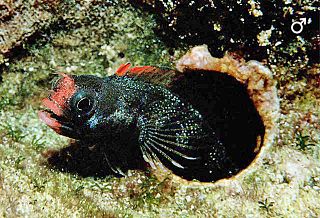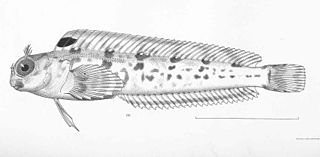
Enneanectes is a genus of triplefin fish in the family Tripterygiidae.

Acanthemblemaria is a genus of chaenopsid blennies native to the Atlantic and Pacific Oceans.

Parahypsos piersoni is a species of combtooth blenny found in coral reefs in the eastern Pacific ocean, from Costa Rica to Peru. The specific name honours C.J. Pierson, who was a member of the expedition to Panama on which the type was collected.
Ekemblemaria is a genus of chaenopsid blennies found in the eastern Pacific and western Atlantic oceans.

Emblemariopsis is a genus of flagblennies found throughout the Atlantic ocean.
Mccoskerichthys sandae, the Tufted blenny, is a species of chaenopsid blenny, found around Costa Rica and Panama, in the eastern central Pacific ocean. It can reach a maximum length of 8 centimetres (3.1 in) TL. This species feeds primarily on small crustaceans including copepods, amphipods, and ostracods. It is the only known member of its genus. The generic name honours the zoologist John E. McCosker, who discovered this blenny and who assisted in the collection of the type and the specific name honours his then wife, Sandra.

The Cocos barnacle blenny is a species of chaenopsid blenny native to the Pacific Ocean waters around Cocos Island, Costa Rica. This species reaches a standard length of 3.2 cm (1.3 in).

The Galapagos barnacle blenny is a species of chaenopsid blenny endemic to coral reefs in the Galapagos Islands, in the southeast Pacific ocean. It can reach a maximum length of 6 cm (2.4 in) TL. The specific name honours a naturalist at the Charles Darwin Foundation, Academy Bay, Santa Cruz Island, Galápagos, Miguel Castro.

The bluntspine blenny is a species of chaenopsid blenny found in coral reefs from Costa Rica to Ecuador, in the eastern central Pacific ocean. It can reach a maximum length of 5.5 centimetres (2.2 in) TL. This species feeds primarily on zooplankton.

Hancock's blenny is a species of chaenopsid blenny found in coral reefs around Costa Rica and Panama, in the eastern central Pacific ocean. and can reach a maximum length of 4.5 cm (1.8 in) TL. This species feeds primarily on zooplankton. The specific name honours the leader of the expedition on which the type was collected, the oil magnate and philanthropist Captain George Allan Hancock (1875-1965).
The Delta pikeblenny is a species of chaenopsid blenny found from Costa Rica to Colombia, in the eastern central Pacific ocean. It can reach a maximum length of 7.5 centimetres (3.0 in) TL. This species feeds primarily on zooplankton.
Coralliozetus springeri is a species of chaenopsid blenny found in coral reefs from Costa Rica to Ecuador in the eastern central Pacific ocean. It can reach a maximum length of 2.5 centimetres (0.98 in) TL. This species feeds primarily on zooplankton. The specific name honours the ichthyologist Victor G. Springer of the US National Museum.
Coralliozetus angelicus, the Angel blenny, is a species of chaenopsid blenny found in coral reefs from the Gulf of California to Acapulco, Mexico, in the eastern central Pacific ocean. It can reach a maximum length of 3.5 centimetres (1.4 in) TL. This species feeds primarily on zooplankton.
Coralliozetus boehlkei, the Barcheek blenny, is a species of chaenopsid blenny found from the Gulf of California to Costa Rica, in the eastern central Pacific ocean. The specific name honours the ichthyologist James E. Böhlke (1930-1982) of the Academy of Natural Sciences of Philadelphia.

Coralliozetus cardonae, the twinhorn blenny, is a species of chaenopsid blenny found in coral reefs in the western Atlantic ocean. It can reach a maximum length of 8.5 centimetres (3.3 in) TL.
Coralliozetus micropes, the Scarletfin blenny, is a species of chaenopsid blenny found in coral reefs in the eastern central Pacific ocean. It can reach a maximum length of 4 centimetres (1.6 in) TL. This species feeds primarily on zooplankton.
Emblemaria nivipes, the whiteback signal blenny, is a species of chaenopsid blenny found around Costa Rica and Colombia, in the eastern central Pacific Ocean. It can reach a maximum length of 4.2 centimetres (1.7 in) SL. This species feeds primarily on zooplankton.
Emblemariopsis ramirezi is a species of chaenopsid blenny known from Venezuela, in the western central Atlantic ocean. The specific name honours Humberto Ramirez, who found this species and drew Cervigón's attention to it.
Stathmonotus culebrai, the Panamanian worm blenny, is a species of chaenopsid blenny found in rocky reefs around Costa Rica and Panama, in the eastern central Pacific ocean. It can reach a maximum length of 5 centimetres (2.0 in) TL.









